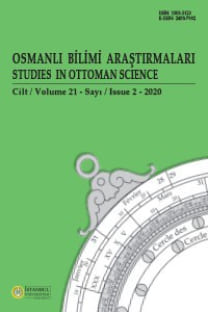Bedreddin Muhammed el-İstanbulî'nin Teslis-i Zaviye (Açıyı Üçe Bölme) ve Tesbi'-i Daire (Daireyi Yediye Bölme) Risaleleri
Problems on trisecting an angle and dividing a circle into seven parts have a significant place in the history of geometry. These problems attracted the attention of Ottoman scientists as well as medieval Islamic mathematicians. Bedreddin el-Istanbulî (18th century) was one of the earliest Ottoman mathematicians who studied these problems. Bedreddin Muhammed, son of the 18th century Ottoman scholar Yanyalı Esad Efendi, was probably educated by his father. He lived in Istanbul and likely in Cairo. Only three of his mathematical works came down to us. The first one is Şarh Ba'zı al-Makalat al-Uklidisiyya and was written in Arabic in 1723 (h.1136). The only manuscript is preserved at the Beyazit State Library in Istanbul (Umumi nr. 9787). This work includes a commentary (Sharh) on some the problems of Euclidian geometry. His other two works are shorter and kept at the Cairo National Library Dar al-Kutub. Their titles are Kitab Taslîs al-Zâviya be Tasb'i al-Da'ira (trisecting an angle and dividing a circle into seven parts) and Kitâb ‘Amal al-Musabba‘ ve gayrihu min zavâti'l-ızlâ‘ li'l-kasira fi'd-Dâ'ira (The inscribing a heptagone and other polygons in a circle). The methods used by Bedreddin Muhammed in his treatises where he often referred to Archimedes and Euclides, are rather sophisticated but correct.. This complexity sometimes led to difficulties in grasping the text. Bedreddin Muhammed tried to present his studies in an abridged form and aimed to inform his colleagues about their practical applications, an approach highly favoured by the Ottomans.
Anahtar Kelimeler:
-
The treatises on trisecting an angle and dividing a circle into seven equals parts by Bedreddin Muhammed el-Istanbulî
Problems on trisecting an angle and dividing a circle into seven parts have a significant place in the history of geometry. These problems attracted the attention of Ottoman scientists as well as medieval Islamic mathematicians. Bedreddin el-Istanbulî (18th century) was one of the earliest Ottoman mathematicians who studied these problems. Bedreddin Muhammed, son of the 18th century Ottoman scholar Yanyalı Esad Efendi, was probably educated by his father. He lived in Istanbul and likely in Cairo. Only three of his mathematical works came down to us. The first one is Şarh Ba'zı al-Makalat al-Uklidisiyya and was written in Arabic in 1723 (h.1136). The only manuscript is preserved at the Beyazit State Library in Istanbul (Umumi nr. 9787). This work includes a commentary (Sharh) on some the problems of Euclidian geometry. His other two works are shorter and kept at the Cairo National Library Dar al-Kutub. Their titles are Kitab Taslîs al-Zâviya be Tasb'i al-Da'ira (trisecting an angle and dividing a circle into seven parts) and Kitâb ‘Amal al-Musabba‘ ve gayrihu min zavâti'l-ızlâ‘ li'l-kasira fi'd-Dâ'ira (The inscribing a heptagone and other polygons in a circle). The methods used by Bedreddin Muhammed in his treatises where he often referred to Archimedes and Euclides, are rather sophisticated but correct.. This complexity sometimes led to difficulties in grasping the text. Bedreddin Muhammed tried to present his studies in an abridged form and aimed to inform his colleagues about their practical applications, an approach highly favoured by the Ottomans.
Keywords:
-,
___
- -
- ISSN: 1303-3123
- Yayın Aralığı: Yılda 2 Sayı
- Başlangıç: 1995
- Yayıncı: İstanbul Üniversitesi Edebiyat Fakültesi
Sayıdaki Diğer Makaleler
Raymond Hovasse'ın Türkiye'deki Bilimsel Çalışmaları ve Baltalimanı Hayvanat İstasyonu'nun Kuruluşu
Osmanlı Devleti'nin Son Eczacılık Yönetmeliği: Eczacılar ve Eczahaneler Hakkında Kararname (1922)
Einstein'ın Görelilik Teorisini Türkiye'ye Tanıtanlar (I): Mehmed Refik Fenmen ve Kerim Erim
İstanbul Darülfünunu Fen Fakültesi Kimya Zümresi Müderris Muavini Mehmed Ali Kağıtçı
